|
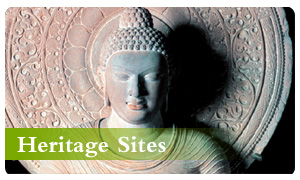 Properties
inscribed on the World Heritage List Properties
inscribed on the World Heritage List
Cultural
Agra Fort
Uttar Pradesh,
Agra District
Brief Description
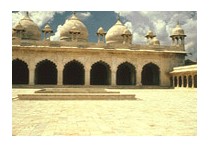 Near
the gardens of the Taj Mahal stands the important 16th-century
Mughal monument known as the Red Fort of Agra. This
powerful fortress of red sandstone encompasses, within
its 2.5-km-long enclosure walls, the imperial city of
the Mughal rulers. It comprises many fairy-tale palaces,
such as the Jahangir Palace and the Khas Mahal, built
by Shah Jahan; audience halls, such as the Diwan-i-Khas;
and two very beautiful mosques. Near
the gardens of the Taj Mahal stands the important 16th-century
Mughal monument known as the Red Fort of Agra. This
powerful fortress of red sandstone encompasses, within
its 2.5-km-long enclosure walls, the imperial city of
the Mughal rulers. It comprises many fairy-tale palaces,
such as the Jahangir Palace and the Khas Mahal, built
by Shah Jahan; audience halls, such as the Diwan-i-Khas;
and two very beautiful mosques.
Ajanta Caves
Maharashtra State,
Aurangabad District ,
Soyagon Taluka,
Lenapur Village
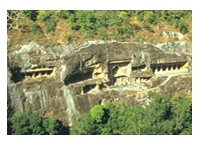 Brief
Description Brief
Description
The first Buddhist cave monuments at Ajanta date from
the 2nd and 1st centuries B.C. During the Gupta period
(5th and 6th centuries A.D.), many more richly decorated
caves were added to the original group. The paintings
and sculptures of Ajanta, considered masterpieces of
Buddhist religious art, have had a considerable artistic
influence.
Buddhist Monuments at Sanchi
Madhya Pradesh
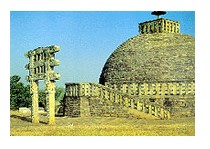 Brief
Description Brief
Description
On a hill overlooking the plain and about 40 km from
Bhopal, the site of Sanchi comprises a group of Buddhist
monuments (monolithic pillars, palaces, temples and
monasteries) all in different states of conservation
most of which date back to the 2nd and 1st centuries
B.C. It is the oldest Buddhist sanctuary in existence
and was a major Buddhist centre in India until the 12th
century A.D.
Champaner-Pavagadh Archaeological Park
Gujarat state,
District of Panchmahal
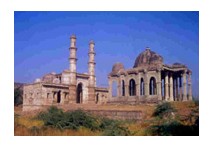 Brief
Description Brief
Description
Brief Description A concentration of largely unexcavated
archaeological, historic and living cultural heritage
properties cradled in an impressive landscape which
includes prehistoric (chalcolithic) sites, a hill fortress
of an early Hindu capital, and remains of the 16th century
capital of the state of Gujarat. The site also includes,
among other vestiges, fortifications, palaces, religious
buildings, residential precincts,agricultural structures
and water installations, from the 8th to the 14th centuries.
The Kalikamata Temple on top of the Pavagadh Hill is
considered to be an important shrine, attracting large
numbers of pilgrims throughout the year. The site is
the only complete and unchanged Islamic pre-Mughal city.
Justification for Inscription Criterion
(iii): The Champaner-Pavagadh Archaeological Park with
its ancient Hindu architecture, temples and special
water retaining installations together with its religious,
military and agricultural structures, dating back to
the regional Capital City built by Mehmud Begda in the
16th century, represents cultures which have disappeared.
Criterion (iv): The structures represent a perfect blend
of Hindu-Moslem architecture, mainly in the Great Mosque
(Jami Masjid), which was a model for later mosque architecture
in India. This special style comes from the significant
period of regional sultanates.
Criterion (v): The Champaner-Pavagadh Archaeological
Park is an outstanding example of a very short living
Capital, making the best use of its setting, topography
and natural features. It is quite vulnerable due to
abandonment, forest takeover and modern life.
Criterion (vi): The Champaner-Pavagadh Archaeological
Park is a place of worship and continuous pilgrimage
for Hindu believers.
Chhatrapati Shivaji Terminus (formerly Victoria
Terminus)
City of Mumbai,
Maharashtra State
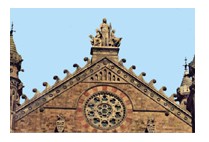 Brief
Description Brief
Description
The Chhatrapati Shivaji Terminus, formerly known as
Victoria Terminus in Mumbai, is an outstanding example
of Victorian Gothic Revival architecture in India, blended
with themes deriving from Indian traditional architecture.
The building, designed by the British architect F.W.
Stevens, became the symbol of Bombay as the othic City
and the major international mercantile port of India.
The terminal was built over ten years starting in 1878
according to a High Victorian Gothic design based on
late medieval Italian models. Its remarkable stone dome,
turrets, pointed arches, and eccentric ground plan are
close to traditional Indian palace architecture. It
is an outstanding example of the meeting of two cultures
as British architects worked with Indian craftsmen to
include Indian architectural tradition and idioms forging
a new style unique to Bombay.
Justification for Inscription
Criterion (ii): Chhatrapati Shivaji Terminus of Mumbai
(formerly Bombay) exhibits an important interchange
of influences from Victorian Italianate Gothic Revival
architecture, and from Indian traditional buildings.
It became a symbol for Mumbai as a major mercantile
port city on the Indian Subcontinent within the British
Commonwealth.
Criterion (iv): Chhatrapati Shivaji Terminus is an outstanding
example of late 19th century railway architecture in
the British Commonwealth, characterized by Victorian
Gothic Revival and traditional Indian features, as well
as its advanced structural and technical solutions.
Chhatrapati Shivaji Terminus (formerly Victoria
Terminus)
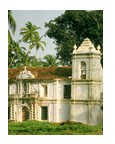 State
of Goa State
of Goa
Brief Description
The churches and convents of Goa, the former capital
of the Portuguese Indies ?particularly the Church of
Bom Jesus, which contains the tomb of St Francis-Xavier
?illustrate the evangelization of Asia. These monuments
were influential in spreading forms of Manueline, Mannerist
and Baroque art in all the countries of Asia where missions
were established.
Elephanta Caves
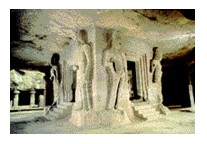 Maharashtra
State, Maharashtra
State,
District Kolaba (Island of Elephanta)
Brief Description
The 'City of Caves', on an island in the Sea of Oman
close to Bombay, contains a collection of rock art linked
to the cult of Shiva. Here, Indian art has found one
of its most perfect expressions, particularly the huge
high reliefs in the main cave.
Ellora Caves
Maharashtra State,
Aurangabad District,
Khulatabad Taluk , Verul Village
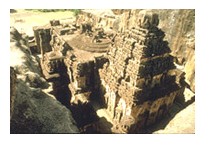 Brief
Description Brief
Description
These 34 monasteries and temples, extending over more
than 2 km, were dug side by side in the wall of a high
basalt cliff, not far from Aurangabad, in Maharashtra.
Ellora, with its uninterrupted sequence of monuments
dating from A.D. 600 to 1000, brings the civilization
of ancient India to life. Not only is the Ellora complex
a unique artistic creation and a technological exploit
but, with its sanctuaries devoted to Buddhism, Hinduism
and Jainism, it illustrates the spirit of tolerance
that was characteristic of ancient India.
Fatehpur Sikri
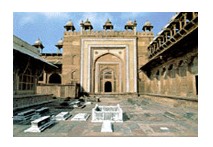 Uttar
Pradesh, Uttar
Pradesh,
Agra District
Brief Description
Built during the second half of the 16th century by
the Emperor Akbar, Fatehpur Sikri (the City of Victory)
was the capital of the Mughal Empire for only some 10
years. The complex of monuments and temples, all in
a uniform architectural style, includes one of the largest
mosques in India, the Jama Masjid.
Great Living Chola Temples
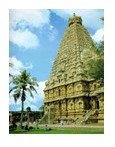 Brief
Description Brief
Description
Two great Chola Temples of the 11th and 12th centuries
have been added to the 11th century Brihadisvara temple
of Thanjavur, inscribed in 1987. The Great Living Chola
Temples were built by kings of the Chola Empire, which
stretched over all of South India and the neighbouring
islands. The site now includes the three great 11th
and 12th century Chola Temples: the Brihadisvara temple
of Thanjavur, the Temple of Gangaikondacholisvaram and
the Airavatesvara temple at Darasuram. The Temple of
Gangaikondacholisvaram, built by Rajendra I, was completed
in 1035. Its 53-m vimana (sanctum tower) has recessed
corners and a graceful upward curving movement, contrasting
with the straight and severe tower at Thanjavur. It
has six pairs of massive, monolithic dvarapalas statues
guarding the entrances and bronzes of remarkable beauty
inside. The Airavatesvara temple complex, built by Rajaraja
II, at Darasuram features a 24-m vimana and a stone
image of Shiva. The temples testify to the Cholas brilliant
achievements in architecture, sculpture, painting, and
bronze casting.
Justification for Inscription
Criterion (i): The three Chola temples of Southern India
represent an outstanding creative achievement in the
architectural conception of the pure form of the dravida
type of temple.
Criterion (ii): The Brihadisvara Temple at Thanjavur
became the first great example of the Chola temples,
followed by a development of which the other two properties
also bear witness.
Criterion (iii): The three Great Chola Temples are an
exceptional and the most outstanding testimony to the
development of the architecture of the Chola Empire
and the Tamil civilisation in Southern India.
Criterion (iv): The Great Chola temples at Thanjavur,
at Gangaikondacholapuram and Darasuram are outstanding
examples of the architecture and the representation
of the Chola ideology.
Notes
The "Brihadisvara Temple, Tanjavur", which
was previously inscribed on the World Heritage List,
is part of the "Great Living Chola Temples".
Group of Monuments at Hampi
Karnataka, Bellary District
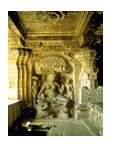 Brief
Description Brief
Description
The austere, grandiose site of Hampi was the last capital
of the last great Hindu Kingdom of Vijayanagar. Its
fabulously rich princes built Dravidian temples and
palaces which won the admiration of travellers between
the 14th and 16th centuries. Conquered by the Deccan
Muslim confederacy in 1565, the city was pillaged over
a period of six months before being abandoned.
Threats to the Site:
The inclusion of the Groups of Monuments at Hampi on
the List of World Heritage in Danger was prompted by
the construction of two suspension bridges which dominate
the natural environment and threaten the World Heritage
site's integrity. The construction of a road towards
one of the bridges will result in a major increase in
heavy goods traffic and has already resulted in the
dismantling and reconstruction of an important historic
monument - a mandapa (a pillared stone rest-house) within
the borders of the site. This dislocation signifies
serious problems in the implementation of cultural heritage
policies and regulations.
Group of Monuments at Mahabalipuram
Tamil Nadu State,
Chingleput District
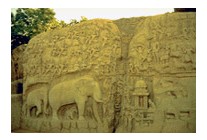 Brief
Description Brief
Description
This group of sanctuaries, founded by the Pallava kings,
was carved out of rock along the Coromandel coast in
the 7th and 8th centuries. It is known especially for
its rathas (temples in the form of chariots), mandapas
(cave sanctuaries), giant open-air reliefs such as the
famous 'Descent of the Ganges', and the temple of Rivage,
with thousands of sculptures to the glory of Shiva.
Group of Monuments at Pattadakal
State of Karnataka,
Bijapur District,
Badami Taluk
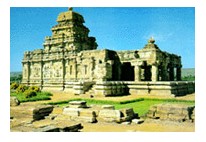 Brief
Description Brief
Description
Pattadakal, in Karnataka, represents the high point
of an eclectic art which, in the 7th and 8th centuries
under the Chalukya dynasty, achieved a harmonious blend
of architectural forms from northern and southern India.
An impressive series of nine Hindu temples, as well
as a Jain sanctuary, can be seen there. One masterpiece
from the group stands out ?the Temple of Virupaksha,
built c. 740 by Queen Lokamahadevi to commemorate her
husband's victory over the kings from the South.
Khajuraho Group of Monuments
State of Madhya Pradesh
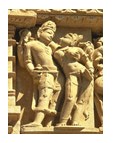 Brief
Description Brief
Description
The temples at Khajuraho were built during the Chandella
dynasty, which reached its apogee between 950 and 1050.
Only about 20 temples remain; they fall into three distinct
groups and belong to two different religions ?Hinduism
and Jainism. They strike a perfect balance between architecture
and sculpture. The Temple of Kandariya is decorated
with a profusion of sculptures that are among the greatest
masterpieces of Indian art.
Mahabodhi Temple Complex at Bodh Gaya
State of Bihar,
Eastern India
Brief Description
The Mahabodhi Temple Complex is one of the four holy
sites related to the life of the Lord Buddha, and particularly
to the attainment of Enlightenment. The first temple
was built by Emperor Asoka in the 3rd century B.C.,
and the present temple dates from the 5th or 6th centuries.
It is one of the earliest Buddhist temples built entirely
in brick, still standing in India, from the late Gupta
period.
Justification for Inscription
Criterion (i): The grand 50m high Mahabodhi Temple of
the 5th-6th centuries is of immense importance, being
one of the earliest temple constructions existing in
the Indian sub-continent. It is one of the few representations
of the architectural genius of the Indian people in
constructing fully developed brick temples in that era.
Criterion (ii) The Mahabodhi Temple, one of the few
surviving examples of early brick structures in India,
has had significant influence in the development of
architecture over the centuries. Criterion (iii) The
site of the Mahabodhi Temple provides exceptional records
for the events associated with the life of Buddha and
subsequent worship, particularly since Emperor Asoka
built the first temple, the balustrades, and the memorial
column.
Criterion (iv) The present Temple is one of the earliest
and most imposing structures built entirely in brick
from the late Gupta period. The sculpted stone balustrades
are an outstanding early example of sculptural reliefs
in stone.
Criterion (vi) The Mahabodhi Temple Complex in Bodh
Gaya has direct association with the life of the Lord
Buddha, being the place where He attained the supreme
and perfect insight.
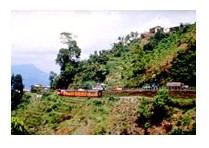 Mountain
Railways of India Mountain
Railways of India
States of West Bengal and Tamil Nadu
Brief Description
Still operational today, these hill passenger railways
crossing regions of great beauty are outstanding examples
of bold, ingenious engineering solutions for the problem
of establishing an effective rail link through a rugged,
mountainous terrain. The Darjeeling Himalayan Railway
opened in 1881, while the Nilgiri Mountain Railway,
though proposed in 1854, was begun in 1891 and completed
in 1908 due to the difficulty of the mountainous location
which scales an elevation of 326m to 2,203m. It was
highly significant in facilitating population movement
and the social-economic development in the British colonial
era.
Justification for Inscription
Criterion (ii): The mountain railways of India are outstanding
examples of the interchange of values on developments
in technology, and the impact of innovative transportation
system on the social and economic development of a multicultural
region, which was to serve as a model for similar developments
in many parts of the world.
Criterion (iv): The development of railways in the 19th
century had a profound influence on social and economic
developments in many parts of the world. The Mountain
Railways of India are outstanding examples of a technological
ensemble, representing different phases of the development
in high mountain areas.
Qutb Minar and its Monuments, Delhi
Delhi
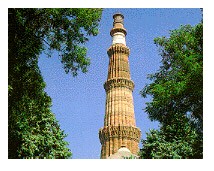 Brief
Description Brief
Description
Built in the early 13th century a few kilometres south
of Delhi, the red sandstone tower of Qutb Minar is 72.5
m high, tapering from 2.75 m in diameter at its peak
to 14.32 m at its base, and alternating angular and
rounded flutings. The surrounding archaeological area
contains funerary buildings, notably the magnificent
Alai-Darwaza Gate, the masterpiece of Indo-Muslim art
(built in 1311), and two mosques, including the Quwwatu'l-Islam,
the oldest in northern India, built of materials reused
from some 20 Brahman temples
Justification for Inscription
The Committee inscribed the site on the World Heritage
List under criterion (iv)
Rock Shelters of Bhimbetka
Madhya Pradesh
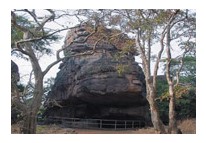 Brief
Description Brief
Description
The Rock Shelters of Bhimbetka are in the foothills
of the Vindhyan Mountains on the southern edge of the
central Indian plateau. Within massive sandstone outcrops,
above comparatively dense forest, are five clusters
of natural rock shelters, displaying paintings that
appear to date from the Mesolithic Period right through
to the historical period. The cultural traditions of
the inhabitants of the twenty-one villages adjacent
to the site bear a strong resemblance to those represented
in the rock paintings.
Justification for Inscription
Criterion (iii): Bhimbetka reflects a long interaction
between people and the landscape, as demonstrated in
the quantity and quality of its rock art.
Criterion (v): Bhimbetka is closely associated with
a hunting and gathering economy as demonstrated in the
rock art and in the relicts of this tradition in the
local adivasi villages on the periphery of this site.
Sun Temple, Konrak
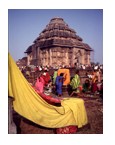 State
of Orissa, State
of Orissa,
Puri District
Brief Description
On the shores of the Bay of Bengal, bathed in the rays
of the rising sun, the temple at Konarak is a monumental
representation of the sun god Surya's chariot; its 24
wheels are decorated with symbolic designs and it is
led by a team of six horses. Built in the 13th century,
it is one of India's most famous Brahman sanctuaries.
Taj Mahal
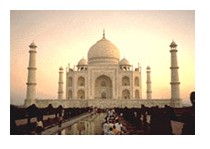 Uttar
Pradesh, Uttar
Pradesh,
Agra District
Brief Description
An immense mausoleum of white marble, built in Agra
between 1631 and 1648 by order of the Mughal emperor
Shah Jahan in memory of his favourite wife, the Taj
Mahal is the jewel of Muslim art in India and one of
the universally admired masterpieces of the world's
heritage.
Natural
 Kaziranga
National Park Kaziranga
National Park
State of Assam
Brief Description
In the heart of Assam, this park is one of the last
areas in eastern India undisturbed by a human presence.
It is inhabited by the world's largest population of
one-horned rhinoceroses, as well as many mammals, including
tigers, elephants, panthers and bears, and thousands
of birds.
 Keoladeo
National Park Keoladeo
National Park
State of Rajasthan,
50 km west of Agra
Brief Description
This former duck-hunting reserve of the Maharajas is
one of the major wintering areas for large numbers of
aquatic birds from Afghanistan, Turkmenistan, China
and Siberia. Some 364 species of birds, including the
rare Siberian crane, have been recorded in the park.
 Manas
Wildlife Sanctuary Manas
Wildlife Sanctuary
State of Assam
Brief Description
On a gentle slope in the foothills of the Himalayas,
where wooded hills give way to alluvial grasslands and
tropical forests, the Manas sanctuary is home to a great
variety of wildlife, including many endangered species,
such as the tiger, pygmy hog, Indian rhinoceros and
Indian elephant.
Threats to the Site:
The Committee decided to include this site on the World
Heritage in Danger List in 1992, when it was invaded
by militants of the Bodo tribe in Assam. Damage to the
sanctuary was estimated at more than two million US
dollars. The site's infrastructure suffered considerable
damage during 1992-93. Political instability seems to
have led to poaching during this period of thirty-three
rhinos during 1989-1992. A monitoring mission jointly
undertaken by the Government of India and the UNESCO
World Heritage Centre in January 1997 confirmed the
extensive damage to Park infrastructure and decrease
in the population of some species, particularly the
greater one-horned rhino.
The Government of India, the State Government of Assam
and the Park authorities have elaborated a $US 2,35
million rehabilitation plan which began to be implemented
in 1997 and is progressing satisfactorily. And while
security conditions in and around Manas have improved,
the threat of insurgency still prevails in the State
of Assam and militants often traverse the sanctuary.
Nevertheless, conditions for site- protection and the
relationship with local villagers appear to be improving.
 Nanda
Devi and Valley of Flowers National Parks Nanda
Devi and Valley of Flowers National Parks
State of Uttaranchal
Brief Description
These are some of the most spectacular wilderness areas
in the Himalayas. Dominated by the peak of Nanda Devi,
which rises to over 7,800 m, Nanda Devi National Park
has remained more or less intact because of its inaccessibility.
It is the habitat of several endangered mammals, especially
the snow leopard, Himalayan musk deer and bharal. The
Valley of Flowers National Park is renowned for its
meadows of endemic alpine flowers and outstanding natural
beauty, and is also home to rare and endangered animals,
including the Asiatic black bear, snow leopard, brown
bear and blue sheep. Together they encompass a unique
transition zone between the mountain ranges of the Zanskar
and Great Himalaya, praised by mountaineers and botanists
for over a century and in Hindu mythology for much longer.
Justification for Inscription
Criterion (iii): The Valley of Flowers is an outstandingly
beautiful high-altitude Himalayan valley that has been
acknowledged as such by renowned mountaineers and botanists
in literature for over a century and in Hindu mythology
for much longer. Its 慻entle' landscape, breath-takingly
beautiful meadows of alpine flowers and ease of access
complement the rugged, mountain wilderness for which
the inner basin of Nanda Devi National Park is renowned.
Criterion (iv): The Valley of Flowers is internationally
important on account of its diverse alpine flora, representative
of the West Himalaya biogeographic zone. The rich diversity
of species reflects the valley's location within a transition
zone between the Zaskar and Great Himalaya ranges to
the north and south, respectively, and between the Eastern
and Western Himalaya flora. A number of plant species
are internationally threatened, several have not been
recorded from elsewhere in Uttaranchal and two have
not been recorded in Nanda Devi National Park. The diversity
of threatened species of medicinal plants is higher
than has been recorded in other Indian Himalayan protected
areas. The entire Nanda Devi Biosphere Reserve lies
within the Western Himalayas Endemic Bird Area (EBA).
Seven restricted-range bird species are endemic to this
part of the EBA.
Sundarbans National Park
West Bengal
Brief Description
The Sundarbans covers 10,000 sq. km of land and water
(more than half of it in India, the rest in Bangladesh)
in the Ganges delta. It contains the world's largest
area of mangrove forests. A number of rare or endangered
species live in the park, including tigers, aquatic
mammals, birds and reptiles.
|



